Contents
Grinding in closed circuit
IF YOU LIKE OUR POSTS AND WANT TO DOWNLOAD ALL OF THEM OFFLINE & IF YOU ARE INTERESTED IN DOWNLOADING THE MOST IMPORTANT BOOKS IN CEMENT INDUSTRY + ALL THE FORMULAS AND EQUATIONS AND CALCULATIONS SHEETS CLICK HERE TO DOWNLOAD THEM
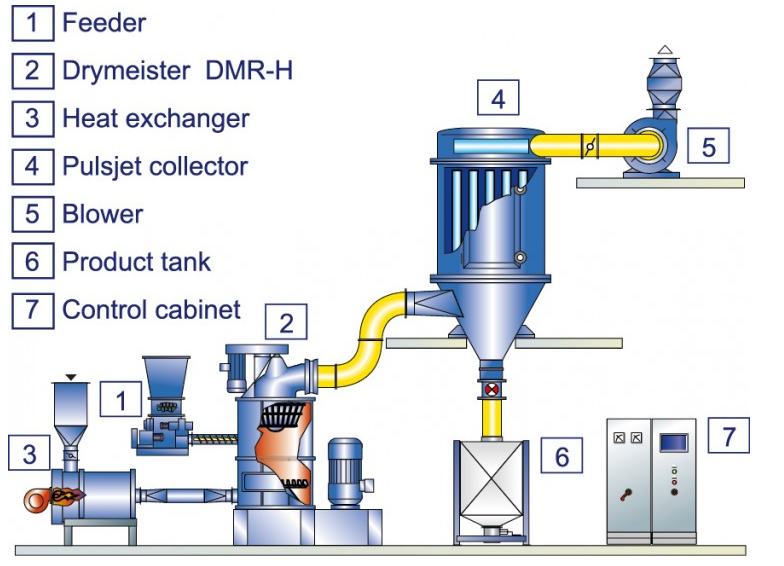
When grinding in closed circuit, the coarses pass through the mill several times. In the separator the fine particles are separated as finished product and do not return into the mill. Because of almost immediate removal of the fine particles from the mill, the fines are characterized by an even granulometric composition.
One pass open circuit grinding performed in long compound mills generates a large number of different particle sizes, thus a broad range of particle sizes; this also includes particle sizes which contaminate the end product.
The grinding work is performed exclusively by the mill. The separator removes only the fine particles which are already a component of the ground mill product; the separator thus improves the size reduc tion conditions of the grinding unit.
Closed circuit grinding plants consist of the tube mill, the elevators, the separators and the fan (see Fig. 12.1.). These auxiliary units require additional energy which amounts to 10-20 % of the mill’s energy requirement. It is hard to prove that the separator mill requires a lower specific grinding energy. At higher Blaine numbers however, the energy require ment for a closed circuit grinding mill is more advantageous.
Fig. 12.1. shows: a. Closed circuit grinding system
- Open circuit grinding system
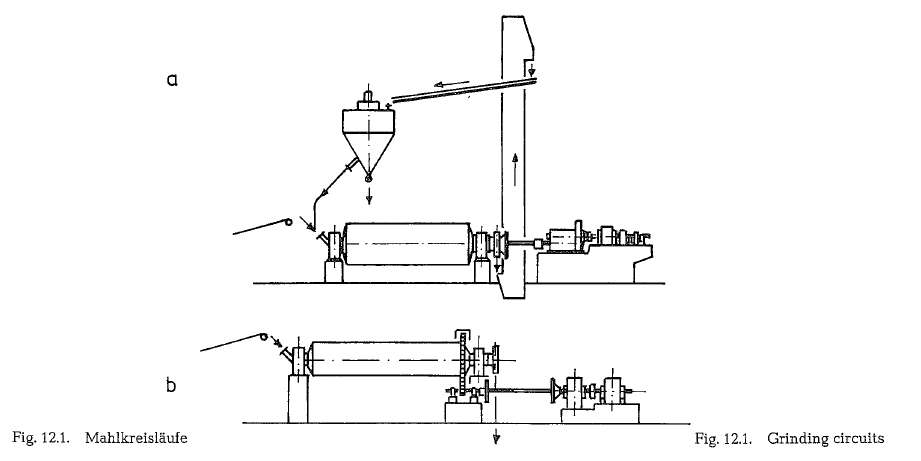
In the finish grinding process, the Blaine-number is not the only consideration; the cement must also have a characteristic granulometric composition.
High Blaine numbers are mostly determined by the fractions of finest particles. However, the finest parti cle fractions alone do not effect the hardening capa city of the cement. In closed circuit grinding the grinding process takes place in the range of coarser particle sizes; by this means, the grinding of unwanted finest particle sizes – which commonly are generated when grinding in open circuit – is being prevented. Closed circuit grinding mills gener ate a range of particle sizes classified as medium broad to narrow. This demonstrates the superiority of the separator mill over the compound mill.
According to Borner [138], grinding mills working in closed circuit produce cement which is hydraulically more active. This means that at the same strength, cement ground in compound mills requires a finer grinding for an amount of 350 Blaine.
According to Keil [139] the mean specific surfaces for different types of cement, ground in compound mills are:
For Portland Cement 27-5 = 3100 cm2/gram
Blaine For Portland Cement 37-5 = 3500 cm2/gram
Blaine For Portland Cement 47-5 = 5200 cm2/gram Blaine
According to the statement cited above, the specific surfaces of these cement types must be the following when ground in closed circuit:
For Portland Cement 27-5 = 3100-350 =
27-50 cm2/gram Blaine
For Portland Cement 37-5 = 3500 – 350 =
3150 cm2/gram Blaine
For Portland Cement 47-5 = 5200- 350 =
4850 cm2/gram Blaine
Using Jacob’s [106] grinding capacity curve, which correlates the specific surface and the so-called grinding capacity factor, it is possible to determine the throughput capacity for cements with various specific surfaces (see Fig. 12.2.).
According to the recent German Cement Standard DIN 1164, issued in November 197-8, the former Port land cement strength classes of 225 or 27-5, 350, 450, and 550 kg/cm2 of compressive strength after 28 days, were divided into cement strength classes Z 25, Z 35, Z 45, and Z 55, i.e. the minimum compressive strength after 28 days expressed in N/mm 2 (N = Newton).
Thus e.g. 45 N/mm2 equals 450 kg/cm2. In addition to minimum values, the quoted standards also require maximum values for 28 days compressive strengths. The maximum values refer to the strength classes Z 25, Z 35, and Z 45. The margin between the lower and upper strength limit is generally in the range of 20 N/mm2. The cement class Z 55 has no upper limit of the compressive strength.
Here it may be pointed out that the minimum Blaine number for all cement types required by the German Standard is 2200, and in some exceptional cases only 2000. An upper limit of the Blaine number is not established.
Pertinent to this it may be noted that the US-ASTM Standard Specification for Portland Cement, requires a minimum Blaine number of 2800 for cement types No. I, II, IV, and V. For high early strength cement, type III, no Blaine number is quoted (Annual Book of ASTM Standards 1974, Part 13, Cement, lime, etc., American Society for Testing and Materials, Philadel phia, Pa. 19103, USA).
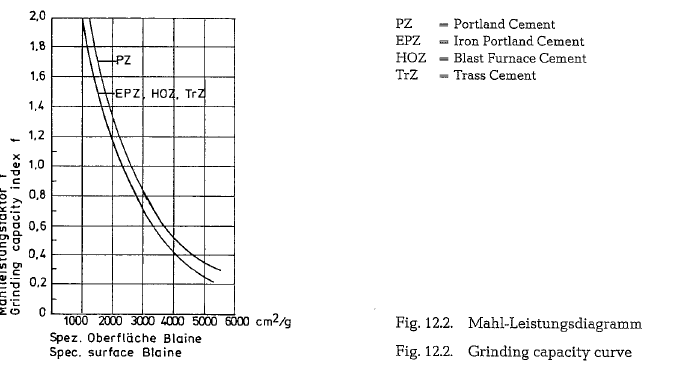
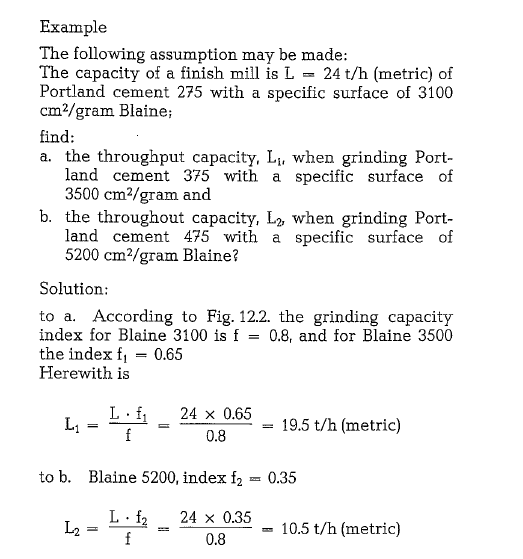
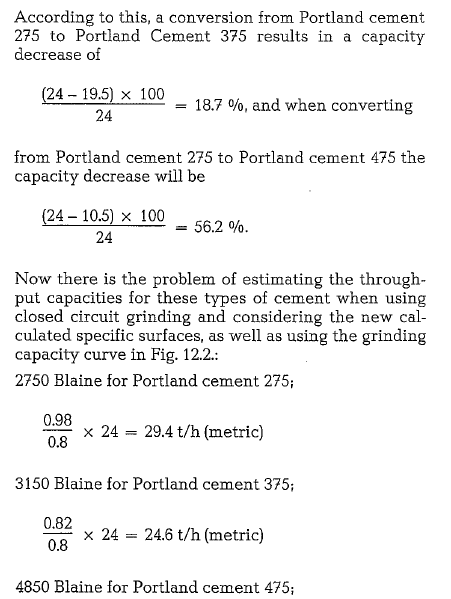
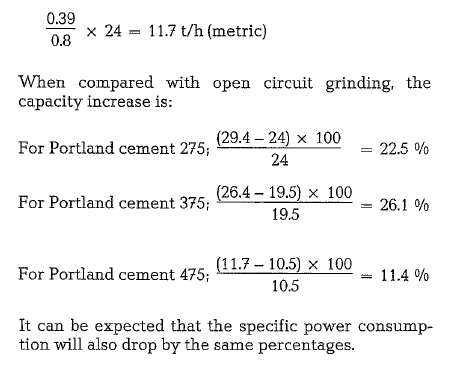
With this calculation, Jacob proves the superiority of the closed circuit mill over the single pass oben cir cuit mill; this is most apparent when grinding high quality cements. The same opinion is expressed by Bellwinkel [140]; he says:
- The specific power demand of large grinding units is 10- 15 % better than that of small
- For higher throughputs, grinding in closed circuit with separators is
- When grinding cement with varying fineness, closed circuit grinding should be preferred because it is more The compound mill is less flexible when changing the scope of duties. Larger compound mills which are adjusted to grind general purpose cements, fail to grind fine cements. Changing the final particle size of a com pound mill requires a change in the composition of the charge of grinding media.
- For combined grinding of different grinding com ponents, the closed circuit is more
Moreover it should be noticed that:
- Cement ground with high circulating load con tains fewer ultra-fine as well as fewer coarse parti cles.
- Closed circuit grinding yields more advantageous wear
- Increasing circulating load when grinding cement results in high late strength; low circulating load yields high early strength
Comparison of grinding mill capacities
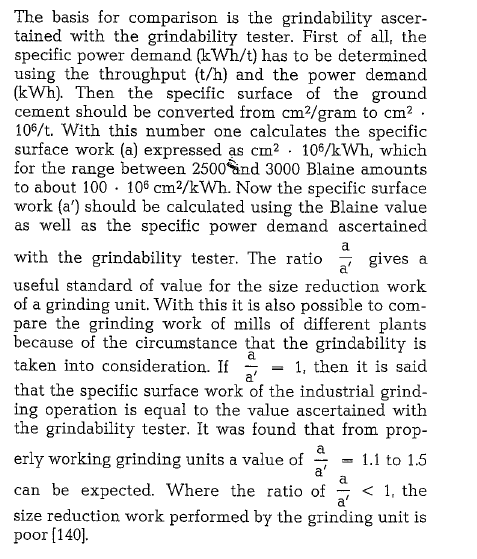
Building space for grinding plants
The graph in Fig. 11.4. shows the savings in invest ment cost when installing larger grinding units as compared with smaller grinding mills. Fig. 12.3. again graphically demonstrates building and space relation ship of a two-mill circuit versus a six-mill circuit of the same grinding capacity and the savings in floor space obtained with the larger mills [141].
Two grinding plants are shown: one with two 4400 HP tube mills, the other with six 1500 HP mills, both plants achieving basically the same grinding results. These two grinding circuits are drawn to the same scale and from actual plant layouts and dimensions. The two-mill line requires a floor space of 963m2, whereas the six-mill circuit requires 2778 m2 of floor space; floor saving is roughly 65 % in favour of the two-mill plant. Construction volume savings are approximately 15 % lower than floor surface savings.
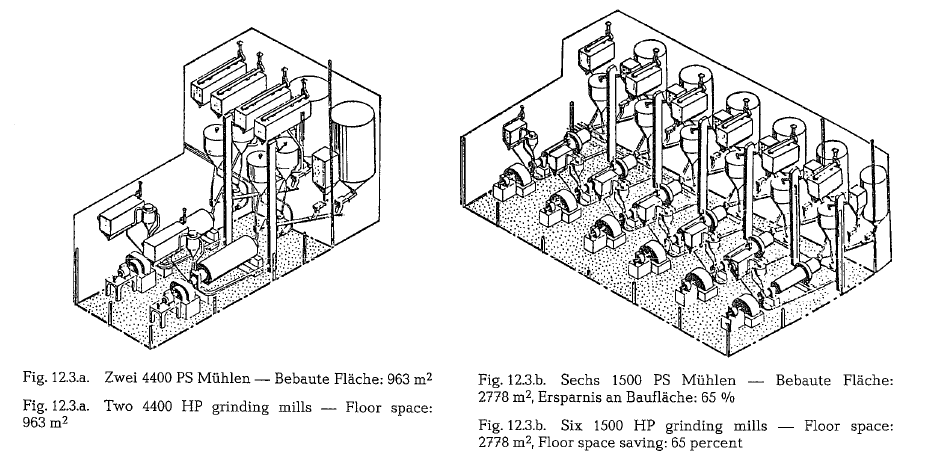
Survey of compound and closed circuit mills
Virtually all the cement produced in the United States is ground in closed circuit grinding mills; i.e. finished cement grinding mills with a yearly produc tion capacity in 1982 of approximately 104 million short tons – not to take for real cement production are closed circuit separator grinding mills. Also, almost all dry raw mills are closed circuit mills.
Of the present total of the finish mills now existing in the Federal Republic of Germany, 35 0/o are equipped with mechanical air separators; 65 0/o of the finish mills grind the cement in single pass open circuit [142]. The yearly production capacity of all finish mills in W. Germany is 50 mill. metric tons of general pur pose cement. The real production in 1982 was 35 mill. metric tons of cement [141a].
At a real cement production rate of 122 mill. metric tons in 1975 in the Soviet Union, there is at present only a minimal number of finish mills of different sizes grinding cement in closed circuit. The reason closed circuit grinding mills have not succeeded (Soviet cement experts substantiate) is as follows:
- Complexity of the machinery of closed circuit grinding
- Frequent defects and shut-downs of the auxiliary equipment caused by its technical
- Lack of operational experience of grinding in closed
- Insufficient theoretical knowledge in the field of closed circuit grinding and air separation [143].
Fine grinding with small grinding media
The tendency to agglomeration causes difficulties when grinding cement clinker in open circuit to higher specific surfaces than 3000-3500 Blaine [143a]. For fine grinding in open circuit, the F. L. Smidth Co, developed a grinding system consisting of two tube mills. The principle of this grinding system, also called Minipebs-system, is shown in Fig. 12.4.
Pre-grinding to a fineness of 2500- 3000 Blaine is per formed in the coarse grinding mill. In the open circuit fine grinding mill, fine particles of up to 6000 Blaine can be attained [143b]. The one-compartment fine grinding mill is filled with 4- 8 mm cylpebs grinding media; because of its small size, the grinding media are called minipebs. According to the manufacturer, this fine grinding system requires less energy than for regular closed circuit grinding (see table 12.1.). To control the grinding temperature, both the coarse and the fine grinding mill, are equipped with water spray cooling. To make the minipebs finish grinding pro cess economically, a grinding aid -usually 200- 300 grams/t of triethanolamine- must be employed. The particle size distribution curve of the finished cement shows the same steepness as for the corresponding cement ground in closed circuit [143c]. This grinding system has already proved its usefulness in a lot of new installations [87c].
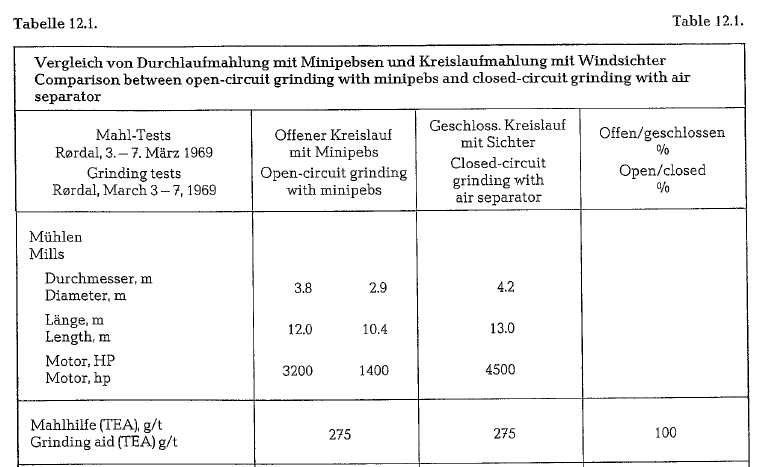
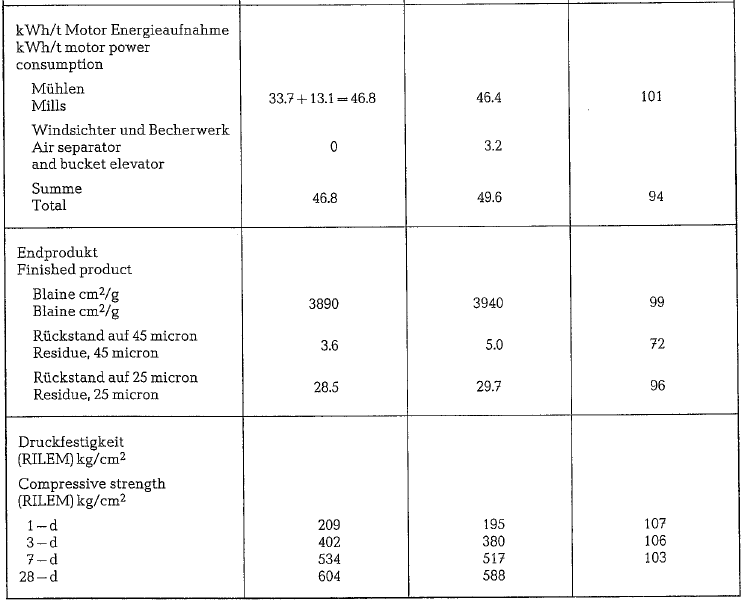
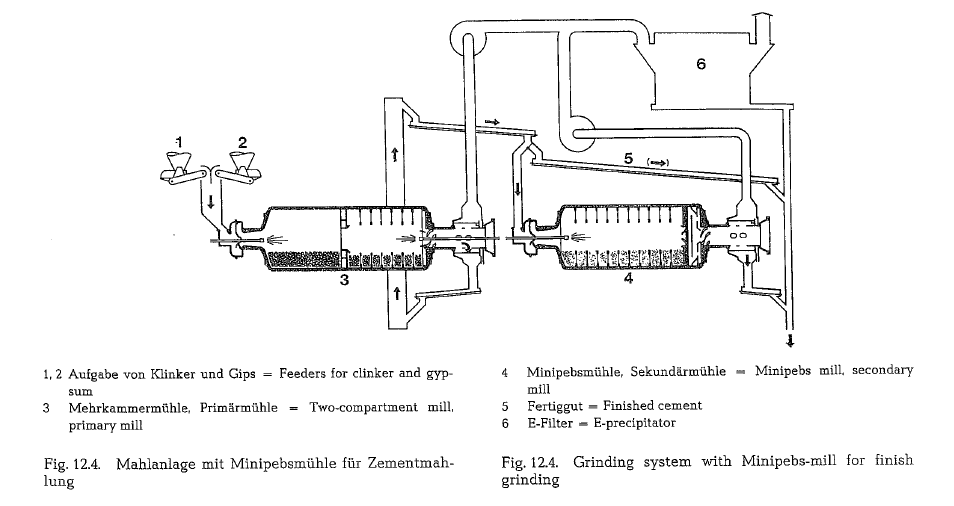
Combidan mill
Based on the good results achieved with its Minipebs mill, F. L. Smidth has developed a new mill unit for grinding of cement clinker, called the Combidan milL
The two-compartment mill shown in Fig. 12.5. has a diameter of 4.6 m and a length of 13 m. The sizes of the grinding media in the fine grinding compartment are in the range of 16 mm down to 4 mm diameter. This results -according to the manufacturer -in a considerable improvement in the grinding economy compared with conventional grinding mills, not only in open circuit but also in closed circuit grinding.

A new-style partition wall prevents the penetration of oversize particles into the fine grinding compart ment of the Combidan milL The outlet of the Combi dan mill is designed according to the same principles as the partition wall so that small grinding balls can not leave the mill together with the finished product. Fig. 12.6. shows the relation between the average weight and the grinding economy of the grinding media.
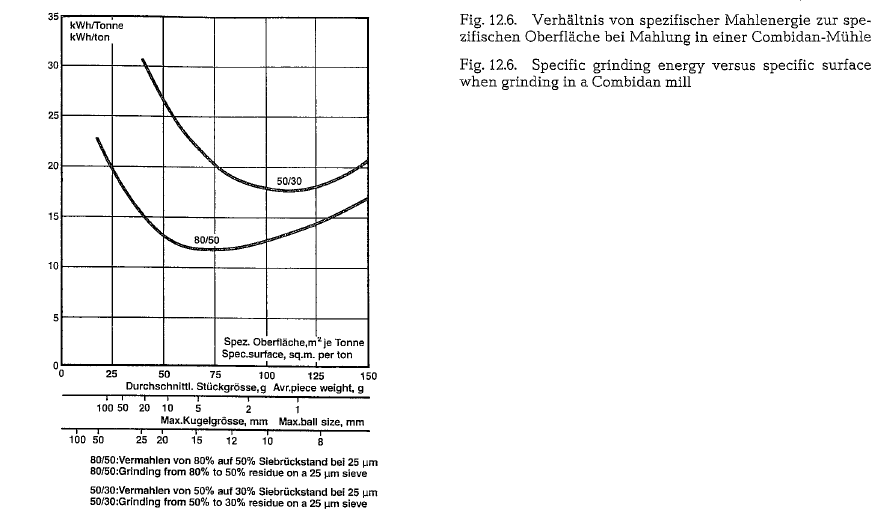
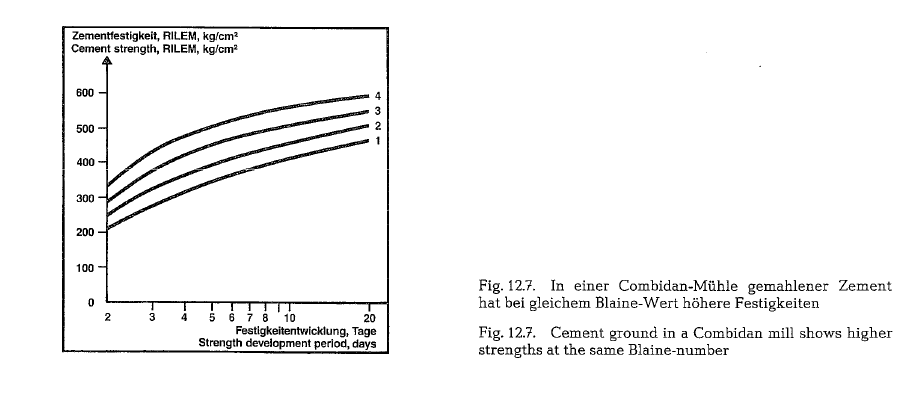
A comparative grinding of the same clinker in a con ventional mill and in a Combidan mill to cement of 3000 cm2/g Blaine showed that the grinding economy of a Combidan mill when grinding in open circuit was 10 % and in closed circuit 12 % better than in a conventional mill.
Another comparative closed circuit grinding of clinker to high early strength cement of 4000 cm2/g Blaine, showed a 14% better grinding economy com pared to grinding of the same mill feed in a conven tional mill.
Besides, F. L. Smidth found that cement from the same clinker ground in a Combidan mill to the same Blaine fineness showed higher strengths than cement in a conventional mill; this relation is shown in Fig. 12.7. [87c].
IF YOU LIKE OUR POSTS AND WANT TO DOWNLOAD ALL OF THEM OFFLINE & IF YOU ARE INTERESTED IN DOWNLOADING THE MOST IMPORTANT BOOKS IN CEMENT INDUSTRY + ALL THE FORMULAS AND EQUATIONS AND CALCULATIONS SHEETS CLICK HERE TO DOWNLOAD THEM
All Information is good…
Can i have some Information about blain..